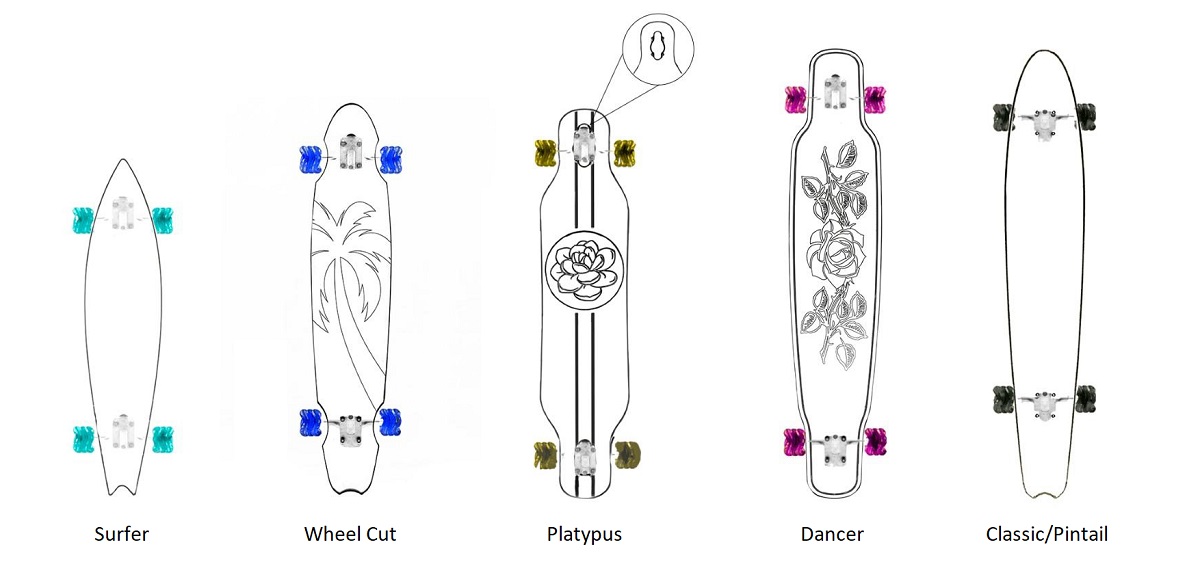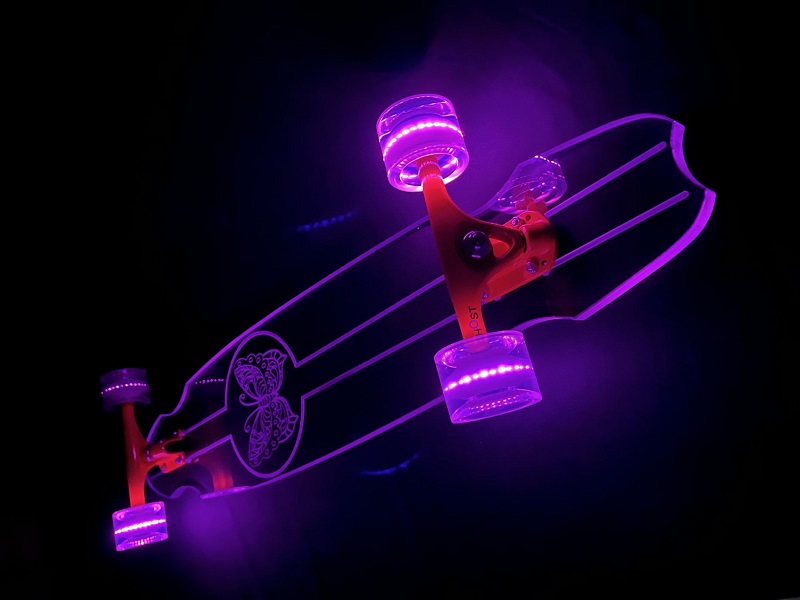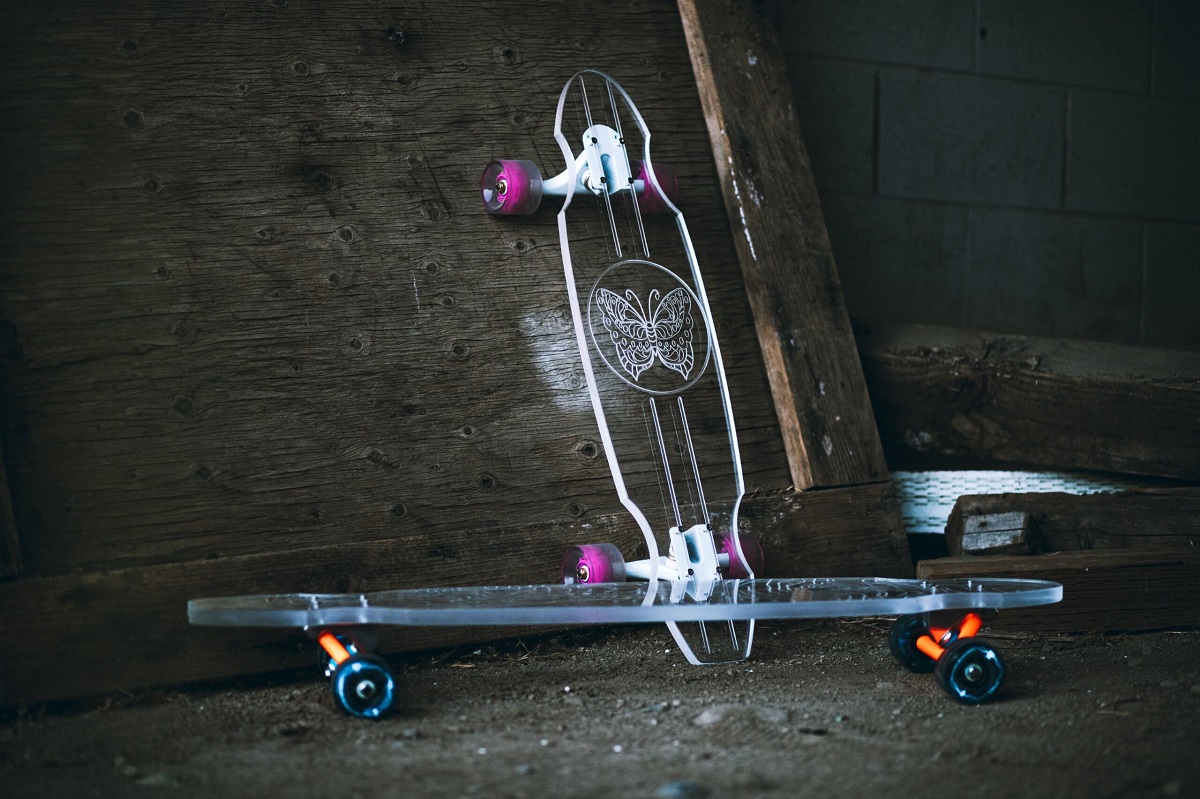With how customizable our longboards are, we often get asked: “What board and parts should I get?” Let’s help you decide by reviewing each part! Then you can pick out your first longboard (or let us build you a custom one) knowing you’re getting the “right stuff.”
Parts of a Longboard

The parts you pick will determine your board’s size, weight, turning radius, speed, stability, and how it handles on different surfaces.
So, it’s important to make sure you’re picking the right components, which include the:
- Deck
- Trucks
- Wheels
- Bearings
- Fasteners
We’re just covering the basics, here. Keep an eye out for links to more in-depth guides about each component of the longboard. There, we go into detail comparing types of parts, and their specifications.
First, Pick a Deck

The deck is the core of the longboard. The three key things to consider when picking a deck are its length, shape, and material.
“Which board length should I pick?”

- Most adult riders choose a 40″ deck. It does everything well.
- The 48″ deck is second in popularity. Good for board dancing, and big/tall riders.
- The 30″ deck is best for young riders. Ideal for carrying and travel.
“Which longboard shape is best for me?”

The shape of your board depends on your riding style and personal preference. These are the most common shapes:
- Surfer. Best for crowded streets and kid riders. Small, light, and nimble.
- Wheel-Cut. For tight turning without wheel bite. Good for large and all-terrain wheels.
- Platypus. The modern do-it-all deck. Balances stability, speed, and turning.
- Dancer. As the name implies, it’s great for board dancing and fancy foot work.
- Pintail. The O.G. longboard. Inspired by surfers. Best for casual cruising.
“What about deck material?”

Deck material is important for determining how stiff or flexible your board feels. Stiff decks are more responsive, albeit with less “cushion” for your feet and ankles. A deck with higher flex will ride smoother, and dampen against hard impacts and shocks.
- Original Ghost Board (acrylic) decks have medium flex with high damping.
- Traditional wood ply decks also have medium flex, but tend to feel springier.
- Solid wood decks are stiff and responsive, with lower damping.
- Aluminum and carbon fiber decks have virtually no flex.
Next, Grab Some Trucks

Trucks connect your deck to the wheels. They also act as your steering mechanism, making them one of the most important parts of the longboard.
“What type of trucks should I get?”
We’ll keep it simple: You should almost always use reverse kingpin trucks on longboards. Reverse trucks provide the best carving ability and tightest turning at slow speeds, while also yielding better stability than standard trucks at high speeds.
For an even more surf-like flow, you should try double kingpin trucks. These aren’t stable at high speed, but they’re unmatched when it comes to making super tight turns.
By default, all Ghost Boards (and most other longboards) come with reverse kingpins.
“What about truck width and angle?”
Longboard truck width is yet another simple thing: 180mm trucks provide the best all-around performance, and it’s what you’ll find on most available boards (skinny, small boards sometimes come with 150mm trucks).
Longboards perform best with high-angle trucks. Nearly all the boards we sell have 50-degree trucks. They allow for easy turning with relatively little lean.
Lastly, Pick Your Wheels and Bearings

The gold standard for long wheels are those measuring 70mm in diameter, with a Durometer A hardness rating of 78a.
Wheels at this size and hardness rating provide good stability with a relatively tight turning radius. They’re able to roll smoothly over small debris and rough surfaces without locking up, but they don’t suffer from too much drag. So, you’re not constantly pushing and tiring out your legs.

Alternatively, you can opt for Shark Wheels. These wavy, grooved wheels are even better at handling debris and rough terrain, but their ribbed design also affords little drag. Although they also have a 78a hardness rating, they’re have a tad more grippy (in this rider’s experience). So, they don’t slide as much as solid wheels — but this may also be something new riders may prefer.
(Grab LED Wheels For Cool Points)

Our LED wheels provide some extra aesthetic! They also provide a 78a hardness rating, with a standard 70mm diameter, ensuring you’re getting the same practical performance with some extra points in the looks department.
Now You’re Ready to Pick (or Build) a Board!

Now that you’re all learned up on the components of a longboard — and which specifications matter most — you can build a custom board. Or, buy a complete that comes set up with your desired specs, and start bombin’ hills and cruising the streets.


